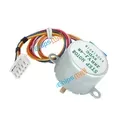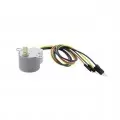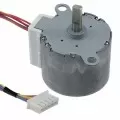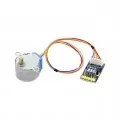OUTLINE:
Servo Motor VS Stepper Motor: Which one is better
 304
304In the electrical world, motors are a big family. Today we will talk about three common members: ordinary motors, servo motors and stepper motors. What are the differences and connections between them? Don't worry, we will explain them in this article.
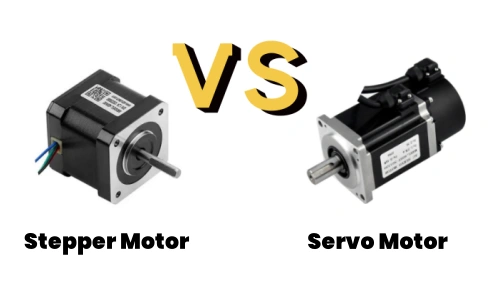
Motors
Let's talk about ordinary motors first.
Ordinary motors are like "old acquaintances" in our daily lives. For example, many motors used in fans and washing machines at home are ordinary motors. Its working principle is not difficult to understand. Simply put, it relies on electromagnetic induction and electromagnetic force to work.
The advantages of ordinary motors are obvious. The structure is simple, which means low cost and easy maintenance. However, it also has shortcomings, that is, the speed regulation performance is not very good and the accuracy is relatively general. Therefore, ordinary motors are generally used in places where speed and accuracy are not required to be high, such as ordinary industrial production and various electrical appliances in our homes.
Ordinary motors usually use simple open-loop control. Open-loop control means that the operating status of the motor is not monitored and adjusted by real-time feedback. It runs according to preset parameters and instructions, and cannot be automatically corrected according to deviations in actual operation. This control method is relatively simple and direct, but the control accuracy and stability are relatively poor.
For example, the motor used to drive ventilation equipment in the factory only needs to provide a stable ventilation effect, and the speed and position accuracy requirements are not high. Ordinary motors can complete the task well.
Servo Motors
Next, let's look at the servo motor.
The servo motor is amazing. It is like a "precision executor". It can control the motor's speed, position and torque very accurately by receiving signals from the controller.
The advantages of the servo motor are really eye-catching. It has super high precision, very fast response speed, and a wide speed range. However, there are gains and losses. The cost of servo motors is relatively high and it is also very complicated to control.
Because of these abilities, servo motors are very popular in CNC machine tools, robots, and automated production lines where control accuracy and dynamic performance are particularly high.
The servo motor uses closed-loop control. In a closed-loop control system, the sensor monitors the actual operating status of the motor in real time, such as speed, position, etc., and feeds this information back to the controller. The controller continuously adjusts the output signal based on the deviation between the feedback and the set value to ensure that the motor runs accurately according to the predetermined requirements. This control method can achieve extremely high accuracy and dynamic response, but the system complexity and cost are also high.
For example, the welding robot on the automobile production line needs to precisely control the position and movement speed of the welding head to ensure the welding quality. At this time, the servo motor is the only choice.

Stepper Motors
Let's talk about stepper motors.
When a stepper motor works, it is driven by a pulse signal, and each rotation has a fixed step angle, so that more accurate position control can be achieved.
It has many advantages, such as simple control method and good positioning accuracy. However, it also has weaknesses. It is easy to lose step when running at high speed, and the output torque is relatively small.
Therefore, stepper motors are generally used in printers, scanners and some small automation equipment, which are more cost-sensitive and do not require very high accuracy.
Stepper motors are based on pulse control. The controller sends a series of pulse signals to the motor, and the motor rotates the corresponding angle and speed according to the number and frequency of pulses received. This control method is relatively simple and intuitive, and easy to implement, but under high speed and complex load conditions, the control accuracy may be affected to a certain extent.
For example, in a 3D printer, a stepper motor can accurately control the movement of the nozzle, realize layer-by-layer printing, and ensure the accuracy and quality of printing.
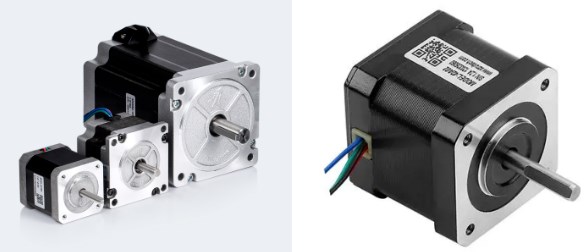
Distinguish the appearance of servo motor vs stepper motor
1. Appearance: The front and rear appearance of stepper motors are basically square, and the appearance of stepper motors is rougher than that of servo motors; the front appearance of servo motors is basically square, but there is a smaller, nearly circular, cover-like thing at the end (with a rotary encoder inside).
2. Lead-out terminal: stepper motors generally have one lead-out terminal; servo motors are all equipped with encoders, so there are two lead output terminals.
3. Rotational resistance: The rotor of a stepper motor cannot be easily rotated by hand without power. Generally, stepper motors are fully enclosed and installed without heat sinks; servo motors also have a certain resistance when rotating, but the static braking torque is much smaller than that of stepper motors.
Servo Motor VS Stepper Motor
The difference between stepper motor and servo motor
There are significant differences between stepper motors and servo motors in four aspects: control method, working principle, and application range. The following are the differences between the two:
1. Working principle
Stepper motors control motor rotation through quantitative pulse signals. Each pulse causes the motor to rotate a fixed step angle, so stepper motors are also called "digital motors". Servo motors achieve precise control of motor speed, position and other parameters through an external feedback mechanism. Therefore, servo motors are also called "analog motors".
2. Control method
The control method of the stepper motor is relatively simple. You only need to provide a pulse signal to the motor to control the rotation of the motor. Servo motors need to monitor the status of the motor in real time through feedback devices such as encoders to achieve precise position, speed, etc. control.
3. Output characteristics
The output characteristics of the stepper motor are relatively simple and can only provide a fixed step angle, so it is suitable for occasions that require quantitative control. Servo motors can achieve more precise position and speed control, and are suitable for occasions with high accuracy requirements.
4. Application scope
Stepper motors are widely used in various situations that require quantitative control, such as printers, CNC machine tools, automation equipment, etc. Servo motors are mainly used in applications that require high-precision position and speed control, such as robots, aerospace, medical equipment, etc.
Which is better, servo vs stepper
It is impossible to generalize which motor is better, because both motors have their own advantages and disadvantages and are suitable for different applications.
The advantages of stepper motors are:
- Relatively low cost;
- Simple and easy to control, no additional feedback controller is required;
- Can be quantitatively controlled;
- Strong subdivision capability and high precision.
But stepper motors also have some disadvantages:
- Limited speed range, prone to stalling at high speed;
- Poor dynamic response, unable to accurately track real-time control signals;
- Suitable for low-load applications, unable to cope with high-load and high-inertia load applications;
- Will generate vibration and noise.
The advantages of servo motors are:
- Can accurately control position, speed and acceleration, good dynamic response performance;
- Can cope with high-load and high-inertia load applications;
- Has better stability and precision at high-speed operation;
- Can maintain stable speed and position during continuous operation.
But servo motors also have some disadvantages:
- Requires additional feedback controllers and encoders and other equipment, which is expensive;
- Has higher requirements for the control system and requires more complex control algorithms;
- Relatively weak subdivision capability.
Where to buy motors
Looking for high-quality motors?
As a trusted distributor, Chipsmall offers a wide range of reliable motors perfect for various applications. Whether you need AC, DC, or stepper motors, our selection caters to all your needs. Enjoy competitive pricing, exceptional customer service, and fast delivery. Our knowledgeable team is ready to help you find the perfect motor for your project.
Conclusion
How to choose from servo motor vs stepper motor? Stepper motors and servo motors have their own strengths, and the appropriate motor should be selected according to the requirements of the specific application. If quantitative control is required and the cost is limited, a stepper motor can be selected; if high-precision position and speed control is required, a servo motor can be selected.

Disclaimer: The views and opinions expressed by individual authors or forum participants on this website do not represent the views and opinions of Chipsmall, nor do they represent Chipsmall's official policy.

share this blog to:


